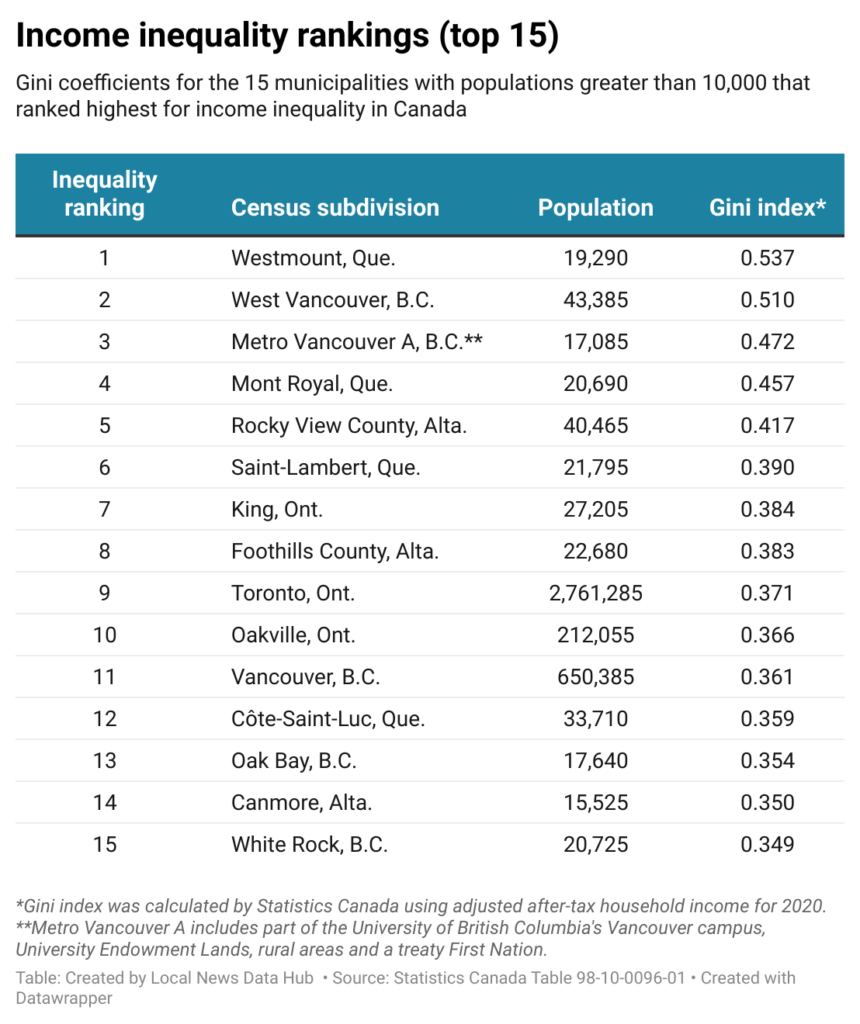
Canmore has one of the widest gaps in Canada between high- and low-income residents, new ranking shows
Town’s income inequality is greater than disparities in Calgary and Edmonton

By Carly Penrose
Local News Data Hub
Sept. 21, 2023
Income inequality, known for its corrosive effects on health, happiness and community ties, is worse in Canmore, Alta., than in most other Canadian municipalities, according to a new analysis of Statistics Canada data.
The mountain resort town, about an hour’s drive from Calgary, ranked 14th for household income inequality on a national list assembled by the Local News Data Hub at Toronto Metropolitan University.
“Many people feel it’s really difficult to earn enough to live and thrive” in Canmore and have to work second jobs, said Lisa Brown, the town’s manager of community social development.
She pointed to a divide between long-term residents struggling to survive and the wealthier people and retirees who come to Canmore for its beautiful surroundings.
Brown said the divisions between high- and low-income residents is evident when it comes to housing options. “Individuals who have significant income or wealth can choose the location of their housing and the type of housing that they live in,” Brown said. “Individuals with lower income tend to take what they can get _ this is often basement suites, shared accommodation, employee housing, their van.”
The Alberta Living Wage Network released a report in 2022 showing that Canmore has the highest cost of living in the province. To cover expenses and thrive in their community, local workers must earn at least $32.75 per hour. The province’s second-highest living wage was in Fort McMurray, at $22.50 per hour.
In places with a high degree of inequality, high- and low-income residents tend to “become socially isolated among people like themselves,” said Ivan Townshend, a social geographer at the University of Lethbridge.
People of different means have fewer opportunities to cross paths when neighbourhoods separate those who “have” from those who “have not,” Townshend said. The isolation can make it easier for rich and poor to form ideas about each other based on stereotypes and then blame the other group for social ills, he added.
Income inequality has been linked to a reduced sense of community belonging, greater distrust among residents, more financial worries and increased anxiety about social status — outcomes all associated with lower levels of happiness and poorer mental and physical health. Research has also associated big income gaps with greater political polarization and increases in theft and vandalism fuelled by desperation and a sense of unfairness.
To compare income inequality across Canada, the Local News Data Hub ranked the country’s 418 municipalities with more than 10,000 people using Statistics Canada’s 2020 Gini index for adjusted after-tax household income.
The Gini index is an internationally recognized tool statisticians use to measure how income is distributed across a society. Income, in this case, takes into account wages, pension income, investment earnings such as dividends and interest, and government transfers like social assistance. The number 1 ranked municipality had the highest level of inequality.
The national ranking, which was reviewed by Statistics Canada senior research analyst Xuelin Zhang, points to significant variations among communities. For instance:
- There were major differences in income inequality among Canadian cities with more than 200,000 people. Toronto was ninth in the overall Gini ranking, Vancouver was 11th, and Montreal was 29th. Edmonton was further down the list in 68th place.
- Other Alberta communities notable for high levels of inequality included Rocky View County and Foothills County near Calgary, which were fifth and eighth in the ranking. Calgary was 22nd.
- The widest gap between high- and low-income residents in Canada was in Westmount, Que., home to about 20,000 people. In Westmount’s richest neighbourhood the median household income is $360,000, according to data from the non-profit Centraide Montreal. The municipality, however, also includes people who live in extremely low-income neighbourhoods on its periphery. The highest-earning 10 per cent of households in Westmount made nearly 11 times more than the lowest earners in 2020.

Statistics Canada data show income inequality declined nationally between 2015 and 2020, largely due to the Canada Child Benefit introduced in 2016 and pandemic-related government transfers like the Canada Emergency Response Benefit (CERB). But David Macdonald, an economist at the Canadian Centre for Policy Alternatives in Ottawa, said inequality and poverty are expected to rise now that CERB payments have ended.
Macdonald also pointed out that the Gini measure tends to underestimate inequality because it is calculated based only on income data and doesn’t include inherited wealth, capital gains or non-financial assets like real estate. “If you include capital gains in the definition of income,” he added, “then you actually see income inequality grow.”
A recent Statistics Canada report illustrated Macdonald’s point. The wealthiest 20 per cent of households controlled two-thirds of the country’s net worth as of early 2023, the report says, while the bottom 40 per cent accounted for just 2.7 per cent. The report also noted that the wealth gap between rich and poor in Canada widened at the fastest pace on record in the first quarter of this year. Compared to the wealthiest households, lower-income Canadians accumulated more debt, saw their savings shrink and received less investment income.
Social justice advocates say there are many ways to reduce income inequality. Bridget Clarke, the advocacy co-ordinator at the St. John’s Status of Women Council in Newfoundland, said stronger pay equity legislation would help.
Labour organizations argue for increases in social assistance, a higher minimum wage and updated labour laws that reduce the number of precarious jobs and make it easier for workers to unionize.
Last year, Halifax Regional Council and the Union of BC Municipalities both passed resolutions calling for a federally funded guaranteed basic income.
This story was produced by the Local News Data Hub, a project of the Local News Research Project at Toronto Metropolitan University’s School of Journalism. The Canadian Press is the Data Hub’s operational partner. Detailed information on the data and methodology can be found here.